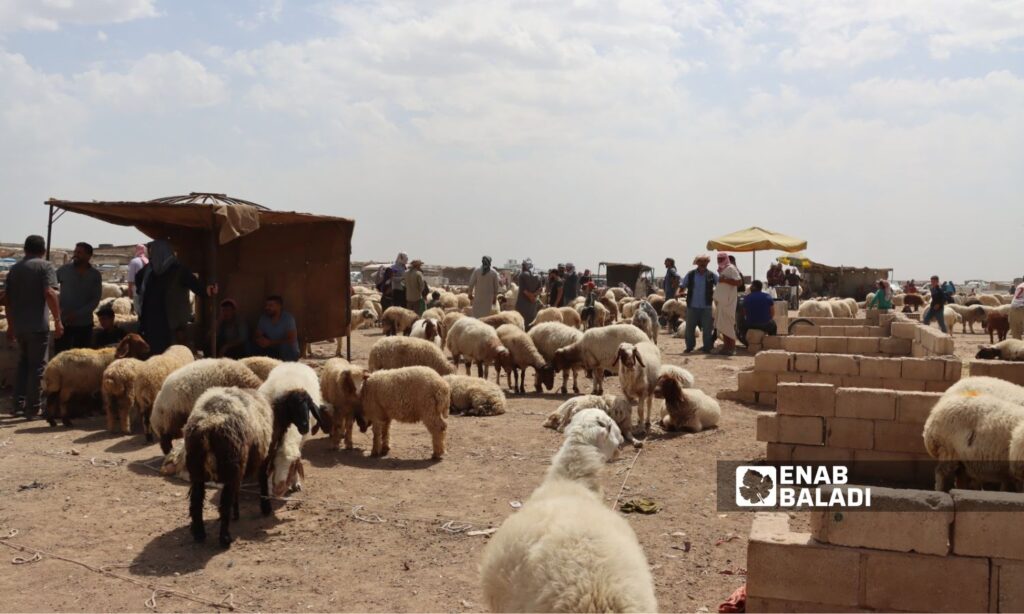Enab Baladi – Jana al-Issa
Khawla, 45, waits for the meat portions distributed as sacrifices during Eid al-Adha each year, as she cooks for her family throughout the following months dishes that require good amounts of meat, which cannot be enough with just a few ounces she buys outside these months.
Khawla’s husband, a government employee, receives a salary of 550,000 Syrian pounds, equivalent to only one and a half kilograms of lamb meat, explaining that she buys meat only when necessary, depending on the dish she will prepare if it is not appropriate to substitute the meat with an alternative.
Khawla does not know the amount of meat expected to arrive during this Eid, explaining that in recent years the quantities have decreased significantly due to the decline in the number of sacrificers because of high prices and poverty.
The kilo approaches the minimum wage
The average selling price of a kilo of lamb in Syria reaches about 350,000 Syrian pounds (about 25 US dollars), which is close to the minimum wages in most control areas.
The minimum wage in regime-controlled areas is 279,000 Syrian pounds (20.5 dollars), and government salaries in the Syrian Salvation Government-controlled Idlib range between 80 and 110 dollars.
Meanwhile, the minimum wage in northeastern Syria, controlled by the Autonomous Administration, reaches one million Syrian pounds (71.5 dollars), and the minimum wages of employees in areas controlled by the Syrian Interim Government in northern and eastern rural Aleppo, Tel Abyad, and Ras al-Ain range between 35 and 59 US dollars.
The high prices of livestock and fluctuations in feed prices are the main reasons for the high prices of meat, coinciding with the weakened purchasing power of the people, with many unable to keep up with the high prices that now include most goods.
With the rising meat prices, many Syrian families in regime-controlled areas look for substitutes for meat to use in their daily meals because they cannot afford to buy it due to its high prices.
Limited income does not allow many families to buy lamb meat, pushing them to use oil, ghee, and meat-flavored “Maggi” (chicken broth cubes) to give the dishes they prepare a meat taste.
Opportunity to eat meat
Since the last Eid al-Adha, Abdullah, 52, a worker at a popular food restaurant in the prison neighborhood of Latakia, has bought meat about three times only, explaining that he buys it according to the money available to him, for example, with 20 or 30 thousand pounds.
Abdullah considers Eid al-Adha a great opportunity to eat meat, despite the fewer sacrifices reaching families compared to the past.
The 50-year-old man believes that under the current circumstances, no one slaughters a sacrifice unless they are a big trader or expatriate, explaining that for at least five years, those who used to buy a sacrifice every year now deserve charity, according to him.
Khadija, 60, a resident of Jalin in the western rural Daraa, told Enab Baladi that Eid al-Adha is an opportunity to eat meat, as she gets about five portions each Eid, with the weight of each portion ranging between half a kilo and a kilo.
Khadija’s family consists of about nine members, including children and grandchildren, with two family members working in seasonal agricultural day labor jobs with wages not exceeding 30,000 Syrian pounds.
Meat has not entered Khadija’s house since the last Eid due to its high prices, as she uses substitutes like chicken meat.
According to several local sources Enab Baladi contacted, sacrifices have become limited to the wealthy and those with expatriates, as the price of a sacrifice does not fall below four million Syrian pounds, an amount difficult to secure for families struggling to meet their daily needs.
A quarter of Syrians are poor
More than a quarter of Syrians live in extreme poverty after 13 years of war that led to successive economic crises and left millions of residents unable to secure their basic needs, according to a report by the World Bank at the end of last May.
According to the report, more than a decade of conflict has significantly deteriorated the well-being of Syrian families, noting that about 5.7 million people, or 27% of Syrians, live in extreme poverty.
Although there was no extreme poverty before 2011, it affected more than one in four Syrians in 2022, and it might have worsened due to the devastating effects of the February 2023 earthquake, according to the World Bank.
Protein off the table
Red meat is considered the best source of high-quality protein, with essential amino acids, as it contains a high percentage of important minerals, non-minerals, and vitamins for health.
Meat is considered a rich source of iron, which is important in preventing anemia, and to follow a healthy diet, red meat should be eaten once or twice a week, especially for young children and women of childbearing age.
As a somewhat cheaper alternative, chicken and turkey meat are considered useful options and can play a role in maintaining a healthy diet that provides the body with its protein needs.
16.7 million people need assistance
In Syria, 16.7 million people need humanitarian assistance, an increase of 9% from 2023, according to estimates by the United Nations High Commissioner for Refugees (UNHCR).
The UNHCR reported that 2024 indicates that the humanitarian and economic indicators in the country continue to deteriorate, and the economic situation is “increasingly dire,” becoming a major driver of needs.
Eighty percent of the Syrian population needs some form of humanitarian assistance in 2024, according to the 2024 Humanitarian Needs Overview (HNO).
About 55% of the Syrian population, or 12.9 million people, suffer from food insecurity, with 3.1 million severely food insecure.
Most Syrians rely on more than one source to try to balance income and expenses. The most prominent of these sources is remittances from expatriates outside Syria and reliance on second jobs, with families giving up essentials in their lives to reduce their spending rate.

